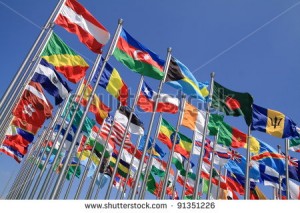 Picking up from the end of Part 1, I’m afraid I left you with the impression that investing in a foreign translation of your book isn’t worth the cost and effort. That may be true for some, but the benefits are pretty awesome too. (Btw, be forewarned… this is a looong post.)
Picking up from the end of Part 1, I’m afraid I left you with the impression that investing in a foreign translation of your book isn’t worth the cost and effort. That may be true for some, but the benefits are pretty awesome too. (Btw, be forewarned… this is a looong post.)
Benefits of Foreign Translations
— You have the opportunity to introduce yourself to a much broader audience; with the accompanying royalties. Plus, WOM works abroad, too. If someone in China falls in love with your story, he/she will recommend it to their friends.
–Through reading your book, someone from another culture will learn about your culture, what drives you, how you look at the world.
–Once your book is translated into one language assuming it does well, it can open doors to more translations in additional languages, thus multiplying the results.
— Modest results in the US might, in another language, become a best-seller. My friend Jamie Freveletti’s first book did well in the US, but in Germany, it was a best-seller. That kind of success is always good for your career going forward whether you are publishing indie or go the traditional route.
So with that in mind, following are the steps you need to consider when you’re producing a foreign translation.
Identify the title and language
—The first step is to take a long hard look at your book. Will it appeal to Spanish language readers? Italian? German? Do they need to read it? Why? Does it add something they can’t afford to miss: a surprise twist, a sympathetic character, an unreliable narrator, a political, economic, or social attitude they don’t have in books of their own language? Just because you’ve written a book or a novel doesn’t mean it’s right for foreign translations.
Your sales figures and reviews (honest reviews) will help. If you’re consistently in top rankings at Amazon and other platforms, and your reviews emphasize how unique your book, it’s a good sign.
—You’ll also need to decide what language to start with. For example, if you’ve written a thriller, Germany might be a good choice, while Spanish might be better in an audio market. Other markets could be smaller and more specialized, and could well be more difficult to reach without an agent who knows the markets and how to negotiate foreign rights.
Choose a Translator and Editor (or two)
You will need two, and possibly three, people who speak the language fluently. The first will be your translator. The second will edit and polish what the translator did. For a translator, I prefer using a native of the country. For an editor, I would recommend a bi-lingual American who can deal with unique American expressions and slang. However, even then, mistakes and awkward constructions can pop up. If you can, a third pair of eyes to proof what the translator and editor did can be helpful.
I recommend you take some time to learn PubMatch. I guarantee you’ll find it fascinating, and you might find a translator and editor there. Of course, you can also ask friends for recommendations.
Publish the translation
You’ll publish the translation just like you do an indie book. Your cover can be variation of the existing one, or it can be different, especially if certain design styles are popular in the country you’ve chosen.
Remember, too, that most readers in other languages still read print books, so I recommend both an ebook and print version. Btw, the print version will include a back cover, which means your English book description and review blurbs will need to be translated. There will be additional translations when you begin marketing (See below), so be sure to include everything when you ask for a quote.
Distribute the book
 Here’s where you need to do a little homework. There’s no question that Amazon and/or iBooks, with all their foreign markets, are great places to start. In fact, I put Bitterer Schleier into Select for a few months so I could go free and try to get some reviews on Amazon.de. I got over 700 downloads, which was great, but they didn’t yield as many reviews as I’d hoped. However, those I did get were quite good. Which was a relief. It also triggered a nice flurry of sales after the price went back up to 4.99 Euros.
Here’s where you need to do a little homework. There’s no question that Amazon and/or iBooks, with all their foreign markets, are great places to start. In fact, I put Bitterer Schleier into Select for a few months so I could go free and try to get some reviews on Amazon.de. I got over 700 downloads, which was great, but they didn’t yield as many reviews as I’d hoped. However, those I did get were quite good. Which was a relief. It also triggered a nice flurry of sales after the price went back up to 4.99 Euros.
After a time, I took Bitterer out of Select and uploaded it to other platforms. In addition to the “usual suspects,” there is a consortium of bookstores and retailers in Germany that, collectively, are doing as well as Amazon. It took a while and some luck with the financial arrangements, but ultimately, I uploaded it to Epubli, where it has since been distributed to other bookstores in the consortium, including Tolino. It’s taken a couple of months, but I started to see some sales just last week.
So it’s useful to research the market in which you’ll be distributing ahead of time. For example, Tolino is about to expand into Netherlands and Denmark, I believe, and it’s worth getting your book on their system.
Promote Your Title
Which brings us to marketing. As in the US, marketing and promotion can be a black hole. I never know what works best or for how long, but here are some thoughts on what I’ve done or am going to do vis a vis translations.
o Offer free copies in exchange for reviews
♣ Facebook groups (readers in Spanish, German, etc) are good sources
♣ Facebook ads are also helpful here
♣ Amazon also has a host customer discussion groups, and while you can’t promote on their lists, you might be able to identify individuals to whom you can email a request
o In addition to the end book material, back cover, book description, ask your translator to translate:
♣ 6-8 tweets in their language about the book
♣ A one page sell sheet (See here for example)
♣ A press release that you’ve written in advance
o Distribute your press release online to the press outlets in the country you’re selling in. Google the major ones— there may be online services like the ones that exist here. If you’re not having any luck, go to your library and ask the reference librarian for help.
o Prepare and place ads on Facebook in the foreign language. It doesn’t have to be expensive, and if you target the right audience, you may have surprising results. Same with Twitter and Google+.
o Explore Facebook, Google+, Goodreads, and Linked-In foreign language readers’ groups to see if there is an appropriate way to get the news out about your book.
o Go free for a period of time
o Do a Goodreads giveaway in the country you’re selling in – not for reviews, but so readers can put it on their TBR lists.
Be Aware of the Bottom Line
As I said before, it’s not going to be cheap, but if you’re like me and you’re willing to invest your profits back into your business, it’s doable.
For example, a Spanish translator starts at $2K. For German, it’s double or triple that..
An Editor will be about $1200.
Publishing and distribution, compared to the above, will be negligible
Promotion is whatever you’re prepared to spend.
Curb Your Expectations
As an Indie Publisher, it’s hard to know what to expect. The process is much slower. I had to go free with two books before I began to see some traction. If you’re with a publisher or Amazon Crossing, sales will undoubtedly be more robust and faster.
But, as I said, it is a long-term investment for me, and one that I hope will ultimately bring a lot of satisfaction.
Questions? What did I leave out? Let me know.